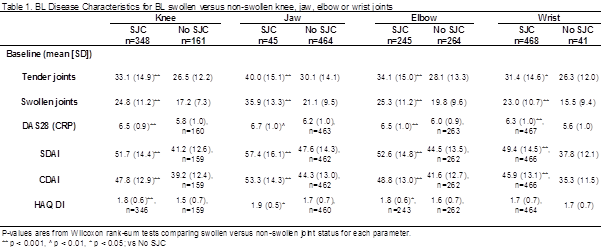Session Information
Date: Monday, October 22, 2018
Title: Rheumatoid Arthritis – Diagnosis, Manifestations, and Outcomes Poster II: Diagnosis and Prognosis
Session Type: ACR Poster Session B
Session Time: 9:00AM-11:00AM
Conclusion: In this cohort of early, seropositive erosive RA, swelling in the knee, jaw, wrist or elbow suggest that large joint locations are associated with the poorest prognosis. Pts with such a presentation might be considered for more intensive treatment.
References: 

To cite this abstract in AMA style:
Durez P, Robert S, Thiry A, Ahmad HA. Identification of Joint Locations That Are Poor Prognostic in an Early Seropositive Erosive RA Cohort [abstract]. Arthritis Rheumatol. 2018; 70 (suppl 9). https://acrabstracts.org/abstract/identification-of-joint-locations-that-are-poor-prognostic-in-an-early-seropositive-erosive-ra-cohort/. Accessed .« Back to 2018 ACR/ARHP Annual Meeting
ACR Meeting Abstracts - https://acrabstracts.org/abstract/identification-of-joint-locations-that-are-poor-prognostic-in-an-early-seropositive-erosive-ra-cohort/
